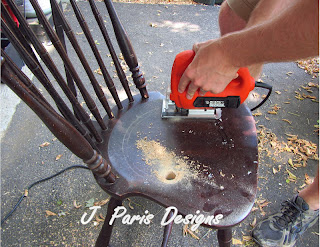Well it only took me 8 years to post some pics of the headboard I made for a client. And yes, I made myself one in the process, but I was too lazy to clean our bedroom to take photos....so you'll have to wait on that one. I'm also going to try my hand at another How-To tutorial because I searched high and low for one to use to give me ideas on where to start. There are TONS out there, but none that really show the "best" way in my opinion.
Materials:
-4'x8' sheet of 1/2" MDF board (Home Depot)
-4'x8' sheet of 1" housing insulation (Home Depot)
-Polyfil low-loft quilt batting - 2 twin size packages (Jo-Ann Fabrics)
-Liquid Nails construction adhesive (Home Depot)
-Nail head trim (Jo-Ann Fabrics)
So here is a premise of what to expect. I wanted to use nailheads as trim around the border of the headboard. The comforter on the bed had a pinstrip that I wanted to emulate. The idea behind the shape was to mimick the shape of the dresser-top mirror in the room. I took measurements of the mirror beforehand and using some mad mathematical skills I was able to keep the proportions appropriate for the headboard.
Drawing the shape on the MDF is pretty self explanatory using a straight edge and a tape measure. The trick is the second layer. Allow me to show you....
See the border? I used a second layer of MDF just along the edge about 4 inches wide. The purpose? Well, the nailheads need something to be nailed into. If I ran the foam all the way to the edge, the nails wouldn't hold. Make sense?
I chose foam housing insulation because it is cheap and lightweight. A lot of tutorials I found said to use high density foam padding from the craft store. Even on a good day, Jo-Ann's sells it for around $20-$30 a yard. That. Is. Ridiculous. I needed something in the center to provide thickness but that wouldn't make it too heavy to hang on the wall. Housing insulation.
I need to note that there are several different kinds. I chose one that was pretty firm, considering it might get bumped and would need to resist crushing. Either way though, I think any of them would work.
So I cut the insulation with a utility knife to fit inside the hollow area. Using Liquid Nails construction adhesive, I attached it to the MDF.
Now we are ready for the quilt batting. You don't need alot to make it look padded. I actually put two layers in the center, but left the edges with just one, again so that the nail head trim would attach correctly.
I chose low-loft because it was slightly less expensive than high or medium and would work just the same. Using my pneumatic stapler, I wrapped it around and stapled it to the back.
Ok, so the next step involves the fabric, which was pure white ultra suede and terrified me. I was so afraid that I would get it dirty. So I took things inside and cleared out the living room to work on the floor where it was clean. Because it was heavy, oddly shaped, and I was by myself trying to wrangle it around, I went without taking pictures. But I think you can get the gist. I laid the fabric out face down, laid the headboard on top face down, and made sure the fabric was pulled tight. Starting on one side, I shot a few staples right in the middle. Moving to the opposite side, I did the same thing. Once all four sides had a few staples in the middle, I started over again. Just make sure to alternate back and forth so you get a good stretch.
Last and final step is the nailhead trim. It comes on a roll with coordinating nail heads that get put in every five nails. No, you don't have to attach each nail individually. Whoever thought up this stuff was a genius.
 |
| This fabric is what I used for my own headboard - stay tuned for that one! |
Make sure to use a rubber mallet, rather than a hammer to make sure the nail heads don't get scratched. Start at one end and work your way around. The trim actually bends very easily for curves and corners.
All that's left is hanging it. Other websites mentioned adding legs to the overall headboard and attach those to the bed frame. That sounded like a lot of extra and unnecessary work. I decided instead to hang it on the wall, just like a picture frame. I used to work at a custom frame shop, so I had all the materials on hand. But any hardware store will sell a picture framing kit. I used two D-ring hangers, one on each side 10" down from the top. Proper picture hooks are designed to hold anywhere from 50 to 100 pounds each, so weight wasn't an issue. Other than that brief info, you are on your own as far as hanging goes.
Finished product:
Side note: Notice the stencil on the wall? I helped my client come up with this idea. She purchased the stencil online and I suggested she have her painter paint the wall in satin finish and the stencil in high gloss (both of the same paint color). It turned out awesome! Perfectly subtle for the decor in the room, but it really pops when the light hits it.
And that's all folks. I hope this helps anyone out there looking to create your own headboard. It wasn't complicated and only required a little ingenuity with the house insulation and picture hanging hardware. Good luck :)
























